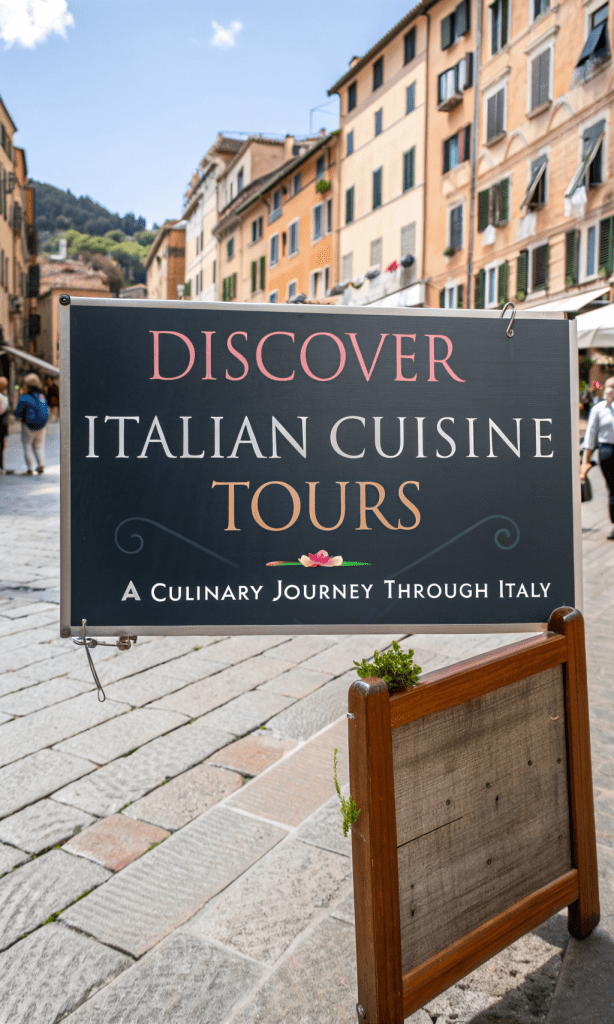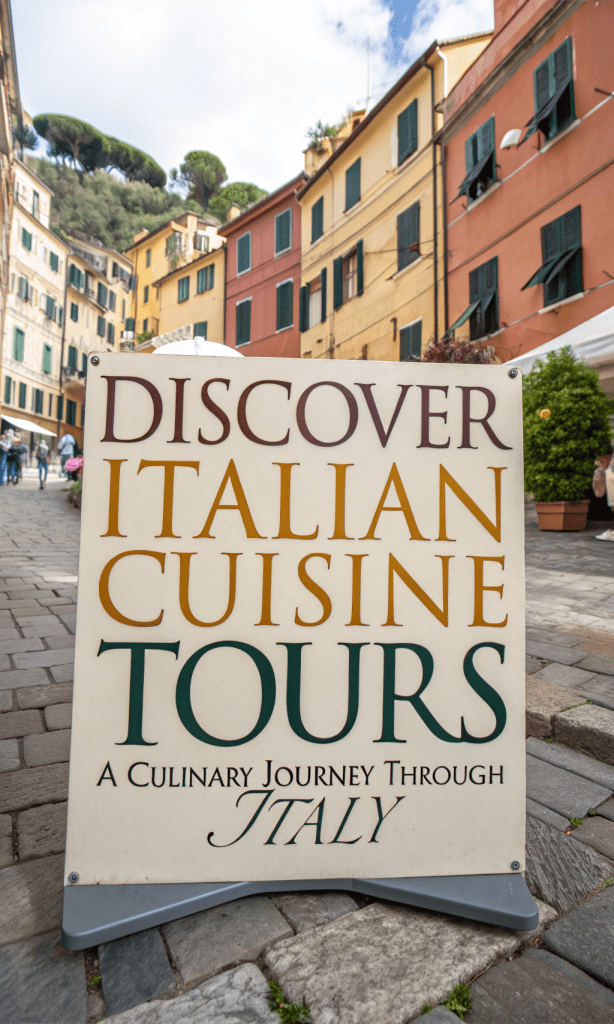
Discover Italian cuisine tours offer an immersive way to experience Italy’s rich food culture. These tours combine travel, history, and gastronomy, allowing you to savor authentic dishes, learn traditional cooking techniques, and explore the origins of Italy’s iconic cuisine. From the rolling hills of Tuscany to the vibrant markets of Sicily, Italian cuisine tours provide a unique opportunity to connect with the heart of Italy through its food. This article dives into what makes these tours special, how to create your own, the origins of Italian cuisine, its nutritional benefits, and key details for planning an unforgettable culinary adventure.
What Are Italian Cuisine Tours?
Italian cuisine tours are guided experiences that focus on Italy’s culinary heritage. You visit local markets, vineyards, and farms, participate in cooking classes, and dine at authentic restaurants. These tours often include hands-on activities like making fresh pasta, crafting tiramisu, or harvesting olives for olive oil production. Expert guides, often local chefs or food historians, lead you through Italy’s diverse regions, sharing stories behind each dish and ingredient.
Unlike standard sightseeing tours, Italian cuisine tours prioritize food as the lens through which you explore the country. You might spend a morning foraging for truffles in Umbria, an afternoon tasting wines in Chianti, or an evening enjoying a multi-course meal in a family-run trattoria. Each experience ties back to Italy’s culinary traditions, offering a deeper understanding of the culture.
Why Choose Italian Cuisine Tours?
Italian cuisine tours stand out for their ability to blend education, adventure, and indulgence. You gain insider knowledge about Italian cooking techniques, regional specialties, and sustainable food practices. These tours cater to food lovers, whether you’re a novice cook or a seasoned chef. They also offer a chance to meet local artisans, farmers, and winemakers, fostering a connection to Italy’s land and people.
The diversity of Italy’s regions makes these tours endlessly varied. In Emilia-Romagna, you might focus on balsamic vinegar and Parmigiano-Reggiano. In Naples, you’ll dive into the art of pizza-making. Each region offers distinct flavors and traditions, ensuring no two tours feel the same. Plus, the social aspect—sharing meals with fellow travelers—creates lasting memories.
The Origins of Italian Cuisine
Italian cuisine traces its roots to ancient times, shaped by the Etruscans, Greeks, and Romans. The Etruscans introduced hearty soups and porridges, while the Greeks brought olive oil and wine-making techniques. The Romans elevated dining with lavish feasts, incorporating spices from their vast empire. However, modern Italian cuisine began to take shape during the Middle Ages, when trade routes introduced new ingredients like tomatoes, potatoes, and corn from the Americas.
The Renaissance period saw Italian cooking become more refined, with cookbooks emerging to document recipes. Regional differences solidified as local climates and economies shaped diets. Northern Italy embraced butter, rice, and polenta, while Southern Italy leaned on olive oil, tomatoes, and pasta. These distinctions remain central to Italian cuisine today, with each region boasting its own specialties.
The 20th century brought Italian cuisine global fame, largely due to Italian immigrants. They shared dishes like pizza and spaghetti with the world, adapting recipes to new environments. Today, Italian cuisine is celebrated for its simplicity, quality ingredients, and respect for tradition, all of which you experience firsthand on Italian cuisine tours.
Nutritional Benefits of Italian Cuisine
Italian cuisine, particularly the Mediterranean diet, is renowned for its health benefits. The focus on fresh, seasonal ingredients, olive oil, and lean proteins contributes to a balanced diet. Here are some key nutritional aspects:
1. Olive Oil as a Healthy Fat
Olive oil, a staple in Italian cooking, is rich in monounsaturated fats and antioxidants. It supports heart health by reducing bad cholesterol levels and inflammation. On Italian cuisine tours, you’ll often visit olive groves to see how this “liquid gold” is produced.
2. Fresh Vegetables and Herbs
Italian dishes emphasize vegetables like tomatoes, zucchini, and leafy greens. These provide vitamins, minerals, and fiber, promoting digestion and immune health. Fresh herbs like basil and oregano add flavor without excess salt, keeping dishes heart-healthy.
3. Whole Grains and Legumes
Pasta, when made from whole grains or paired with legumes like lentils and chickpeas, offers complex carbohydrates and protein. These keep you full longer and stabilize blood sugar. Many tours include lessons on making fresh pasta, highlighting its wholesome ingredients.
4. Lean Proteins
Italian cuisine uses moderate amounts of lean meats, fish, and cheeses. Dishes like grilled seafood in Liguria or prosciutto in Parma provide protein without excessive saturated fats. You’ll learn portion control, a key aspect of the Mediterranean diet, during cooking classes.
5. Wine in Moderation
Red wine, consumed in moderation, is a hallmark of Italian meals. It contains antioxidants like resveratrol, which may benefit heart health. Wine tastings on Italian cuisine tours teach you to pair wines with food for maximum enjoyment and balance.
Studies, like those from the American Heart Association, show the Mediterranean diet reduces risks of heart disease, diabetes, and obesity. Italian cuisine tours let you experience this diet in its authentic form, with meals prepared fresh and shared communally.
How to Create Your Own Italian Cuisine Tour
Crafting your own Italian cuisine tour allows you to tailor the experience to your tastes and schedule. Follow these steps to design a memorable journey:
Step 1: Choose Your Regions
Italy’s 20 regions each offer unique culinary traditions. Focus on one or two to dive deep into their specialties. Popular choices include:
- Tuscany: Known for ribollita (vegetable soup), bistecca alla fiorentina (grilled steak), and Chianti wines.
- Emilia-Romagna: Home to lasagna, tortellini, and Parmigiano-Reggiano cheese.
- Sicily: Famous for arancini, caponata, and citrus-infused desserts.
- Piedmont: Renowned for truffles, Barolo wine, and hazelnut-based dishes.
Research regional specialties to decide which align with your preferences. For example, seafood lovers might prioritize coastal areas like Liguria or Campania.
Step 2: Plan Your Activities
A great Italian cuisine tour balances cooking, tasting, and cultural exploration. Include these activities:
- Cooking Classes: Learn to make regional dishes like tagliatelle in Bologna or cannoli in Palermo. Look for classes led by local chefs.
- Market Visits: Explore vibrant markets like Florence’s Mercato Centrale to shop for fresh produce and connect with vendors.
- Farm and Vineyard Tours: Visit olive groves, dairy farms, or vineyards to see where ingredients come from. Many offer tastings.
- Dining Experiences: Book meals at family-run trattorias or Michelin-starred restaurants for a mix of casual and fine dining.

Step 3: Find a Guide or Tour Operator
While you can plan independently, a local guide enhances the experience. They provide insider access to hidden gems, like a small-batch winery or a family’s private kitchen. Reputable tour operators, such as those offering small-group Italian cuisine tours, handle logistics like transportation and bookings. Look for operators with strong reviews and a focus on authenticity.
Step 4: Set a Budget
Italian cuisine tours vary in cost. Budget-friendly options might include day trips or self-guided market visits, while luxury tours offer private chefs and exclusive tastings. Expect to spend $100–$300 per day for guided tours, depending on inclusions like meals, classes, and accommodations. Plan for additional costs like souvenirs or extra wine tastings.
Step 5: Book in Advance
Popular tours, especially in peak seasons (spring and fall), fill up quickly. Reserve cooking classes, restaurant tables, and accommodations at least 3–6 months ahead. Check visa requirements and ensure your passport is valid for at least six months beyond your travel dates.
Must-Visit Destinations for Italian Cuisine Tours
To inspire your planning, here are top destinations for Italian cuisine tours, each with its own culinary highlights:
1. Florence, Tuscany
Florence is a hub for Tuscan cuisine, known for its rustic simplicity. Join a cooking class to make pappardelle with wild boar ragù or visit a vineyard for Chianti tastings. The city’s markets, like San Lorenzo, brim with fresh produce and artisanal products.
2. Bologna, Emilia-Romagna
Nicknamed “La Grassa” (The Fat One), Bologna is a food lover’s paradise. Learn to roll out fresh pasta for tortellini or sample aged balsamic vinegar in nearby Modena. The city’s food markets and historic eateries offer endless exploration.
3. Naples, Campania
Naples is the birthplace of pizza, and tours here often include pizza-making classes with master pizzaiolos. Savor Neapolitan street food like sfogliatella (pastry) and visit nearby Sorrento for limoncello tastings.
4. Palermo, Sicily
Sicily’s cuisine blends Italian, Arab, and Greek influences. Tours in Palermo feature street food markets like Ballarò, where you can try arancini and panelle. Cooking classes often focus on seafood dishes and desserts like cassata.
5. Alba, Piedmont
Alba is the heart of truffle country. Join a truffle-hunting tour with trained dogs, then enjoy dishes like tajarin (egg yolk pasta) with shaved white truffles. Pair your meals with Barolo or Barbaresco wines.
Tips for an Unforgettable Italian Cuisine Tour
Maximize your experience with these practical tips:
- Pack Comfortably: Bring comfortable shoes for market walks and loose clothing for indulgent meals. A small notebook helps you jot down recipes or tips from chefs.
- Learn Basic Italian: Phrases like “buon appetito” (enjoy your meal) or “grazie” (thank you) go a long way with locals.
- Respect Dietary Needs: Many tours accommodate vegetarian, vegan, or gluten-free diets. Communicate your needs when booking.
- Stay Flexible: Small-group tours may adjust itineraries based on seasonal ingredients or local events. Embrace spontaneity for unique experiences.
- Savor Slowly: Italian meals are leisurely. Take time to enjoy each course and the company of your fellow travelers.
Cultural Significance of Italian Cuisine
Italian cuisine is more than food—it’s a way of life. Meals are a time for family, community, and celebration. The concept of “convivialità” (togetherness) shapes dining, with long lunches and dinners fostering connection. Italian cuisine tours immerse you in this tradition, whether you’re sharing a meal with a winemaker’s family or toasting with new friends at a vineyard.
Food also reflects Italy’s history and geography. Coastal regions emphasize seafood, while mountainous areas favor hearty meats and cheeses. Ingredients like tomatoes, olives, and grapes tie back to Italy’s agricultural roots, and tours highlight the care farmers take to preserve these traditions.
Sustainability in Italian Cuisine
Italian cuisine tours often emphasize sustainability. Many farms and producers practice organic or biodynamic methods, minimizing environmental impact. For example, Parmigiano-Reggiano makers follow strict regulations to maintain quality and tradition. Tours may include visits to zero-waste kitchens or discussions on how climate affects vineyards, giving you insight into Italy’s commitment to sustainable food systems.
How to Choose the Right Italian Cuisine Tour
With countless options, picking the right tour depends on your goals. Ask these questions:
- What’s the group size? Small groups (8–12 people) offer a more intimate experience.
- What’s included? Check if meals, classes, and transportation are covered.
- Is it hands-on? If you love cooking, prioritize tours with multiple classes.
- Does it match your pace? Some tours are fast-paced, while others allow more downtime.
- Is it authentic? Look for tours led by locals or those focusing on family-run businesses.
Reading reviews on platforms like TripAdvisor or asking for recommendations from foodie friends can help you choose a reputable operator.
Embark on Your Italian Cuisine Tour
Discover Italian cuisine tours unlock the soul of Italy through its food. You’ll taste the freshest ingredients, learn time-honored recipes, and connect with the people who make Italian cuisine extraordinary. Whether you’re kneading dough in a Tuscan farmhouse or sipping wine in a Sicilian vineyard, these tours offer a sensory journey like no other. Plan your adventure today, and let Italy’s flavors guide you to unforgettable memories.

